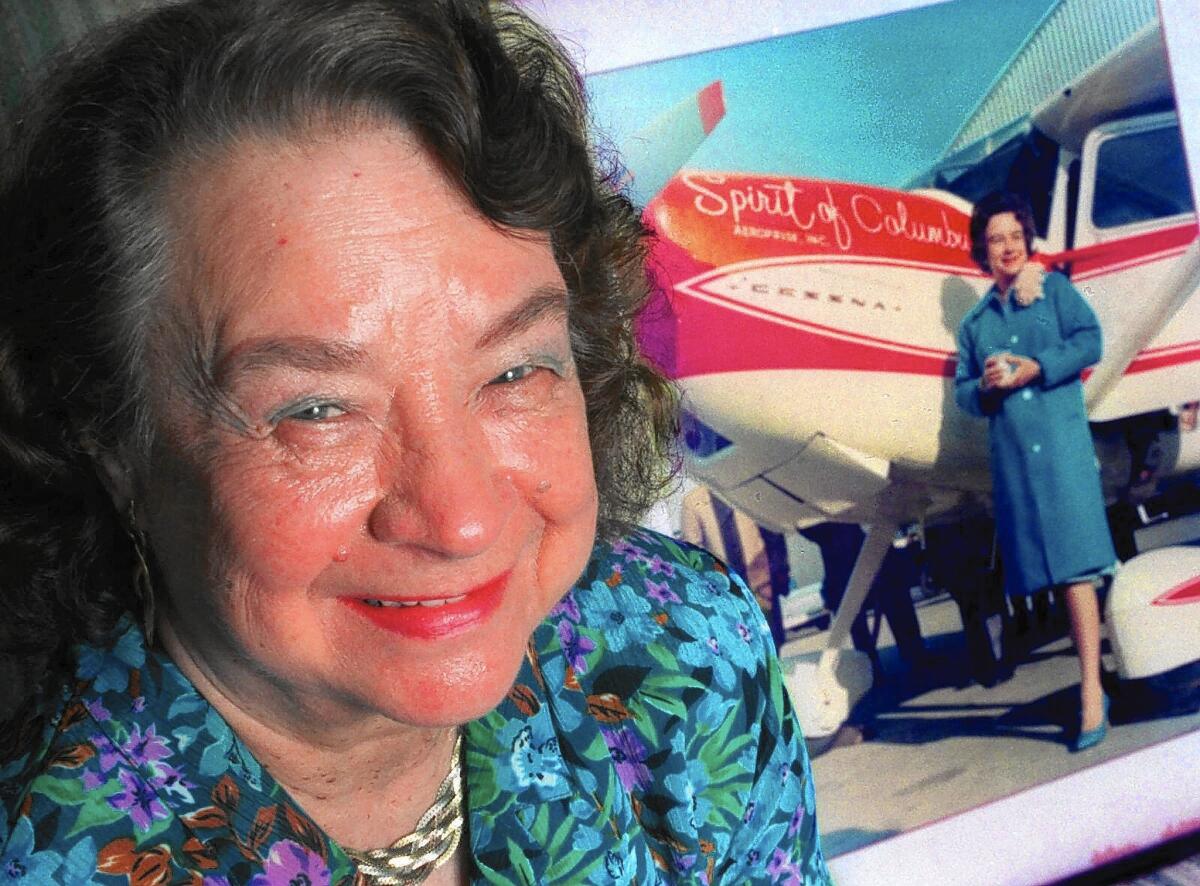Geraldine ‘Jerrie’ Mock dies at 88; first woman to fly solo around world

- Share via
In the mid-1960s, Geraldine “Jerrie” Mock was seen at airports around the world, dressed in a blouse, skirt, high heels and pearls. But she was not on business trips or working as a flight attendant.
Dubbed “the flying housewife,” Mock was a pilot on a quest to make aviation history.
On April 17, 1964, after a 23,000-mile journey that included some perilous situations, she became the first woman to fly solo around the globe.
Mock, 88, died Tuesday at her home in Quincy, Fla., of natural causes, said her sister Susan Reid.
Her historic feat came at a time when female pilots, including Mock, still had to put up with guff from male counterparts. But she ignored them.
“Nobody was going to tell me I couldn’t do it because I was a woman,” she told the Associated Press earlier this year.
Born Geraldine Lois Fredritz on Nov. 22, 1925, in Newark, Ohio, she took her first flight at 7.
“It was so nice to look down at the houses,” she said in a 1994 interview with the Columbus Dispatch. “I decided that would be the way to see the world.”
She studied aeronautical engineering at Ohio State University but left in 1945 to marry fellow student Russell Mock, who was a pilot. She earned her pilot’s license in 1958 and they took part-ownership of a single-engine Cessna 180 airplane.
Mock enjoyed trips from their home airport in Columbus, Ohio, but she pined for more adventure. Her childhood hero had been aviation pioneer Amelia Earhart, who disappeared in the Pacific along with her navigator, Fred Noonan, while trying to make a flight around the globe in 1937. Mock had taken it for granted that since then, a woman pilot had accomplished an around-the-world solo flight.
“When I discovered that none had,” she told the Columbus Dispatch, “I was rather disgusted that women were so backward.”
She began planning her round-the-world flight in 1962. With the permission of the co-owner to make modifications to the 11-year-old Cessna, three extra fuel tanks, an autopilot system and special radios were installed.
Mock preferred wearing trousers for flying, but it was considered prudent to go with a less casual outfit. “She was in a skirt because she thought it would be socially acceptable, especially in the Middle East,” said Wendy Hollinger, publisher of “Three-Eight Charlie,” an account of the flight.
She at least wore comfortable shoes in the cockpit. “She always put on kitten heels when she got out of the plane,” said Mary Kelley, who helped raise funds to erect a statue of the pilot unveiled earlier this year at Ohio’s Port Columbus International Airport.
Preparations for the flight were hastened when Mock found out that Joan Merriman Smith of Long Beach was planning a solo round-the-world flight. “It became a race,” Mock told the Dispatch.
Mock took off from Columbus on March 19, 1964, two weeks earlier than expected, heading to Bermuda. Then came a 2,200-mile leap to the Azores in the North Atlantic, where the first serious trouble arose — ice on her wings. “When I was a student, I was told never to get into icing conditions if you don’t have a de-icer. There I was and there was not much I could do about it.” After anxious moments, she got above the clouds and the ice melted.
Another crisis was born of a blunder — reaching Egypt, she thought she had landed at Cairo’s airport. But instead, she was on a military base and armed soldiers surrounded the plane. Perhaps in part because they were surprised to find that the pilot was a woman, they simply directed her to the right airport.
Not long after, when she landed in Dhahran, Saudi Arabia, soldiers searched the cramped plane. “They thought I had a man hidden behind the gas tank,” she told the Dispatch. When it was found she didn’t, she got a round of applause.
The most serious situation was a burning wire Mock spotted while in flight. That could have been disastrous in a cockpit laden with extra fuel, but she was able to extinguish it.
Mock landed in Columbus to a cheering crowd in the thousands, far ahead of the competing pilot who had mechanical trouble.
She was invited to the White House, where President Johnson congratulated her, and she was interviewed on the “Today” show.
Her national fame was brief, however, and after going on to set several speed records, Mock eventually gave up flying because of the expense of keeping up a plane.
But she never gave up her love of flying. In 2004, she told the Columbus Dispatch that she and friends were going to celebrate the 40th anniversary of her flight by going to a small airport near her Florida home.
“I’m going to watch some airplanes,” she said, “maybe take a ride.”
In addition to her sister, who lives in Newark, Ohio, Mock is survived by a daughter, Valerie Armentrout of Reynoldsburg, Ohio; 12 grandchildren and 13 great-grandchildren. She was predeceased by two sons. She and Russell Mock divorced in the late 1970s, and he died in 1991.
david.colker@latimes.com
Twitter: @davidcolker
Start your day right
Sign up for Essential California for the L.A. Times biggest news, features and recommendations in your inbox six days a week.
You may occasionally receive promotional content from the Los Angeles Times.




